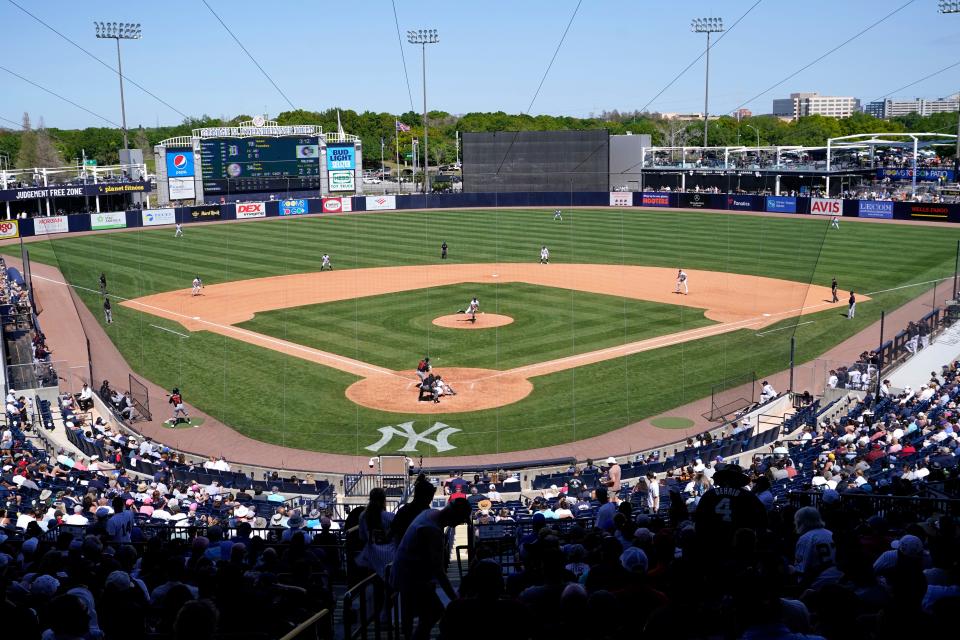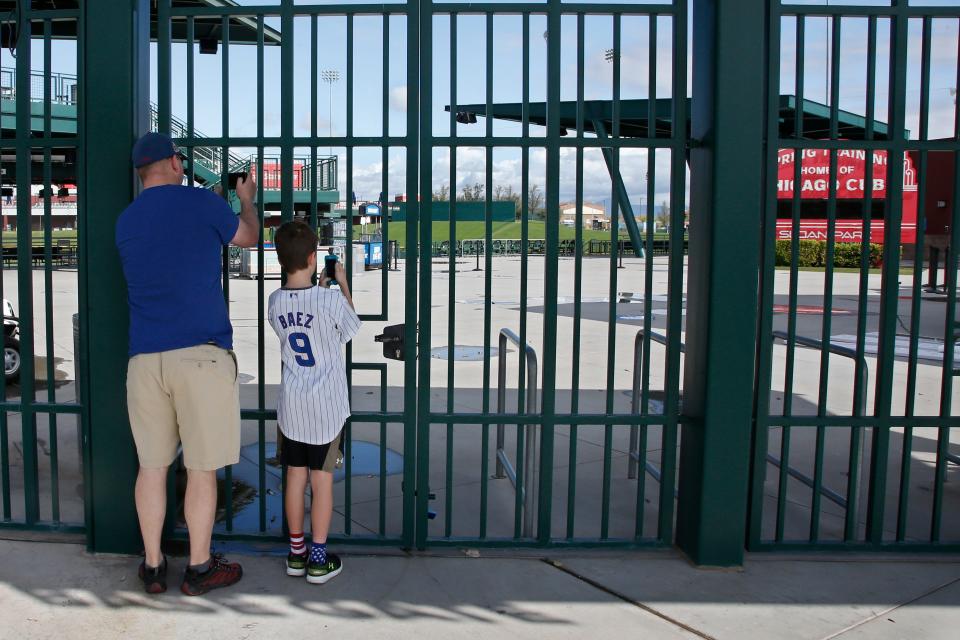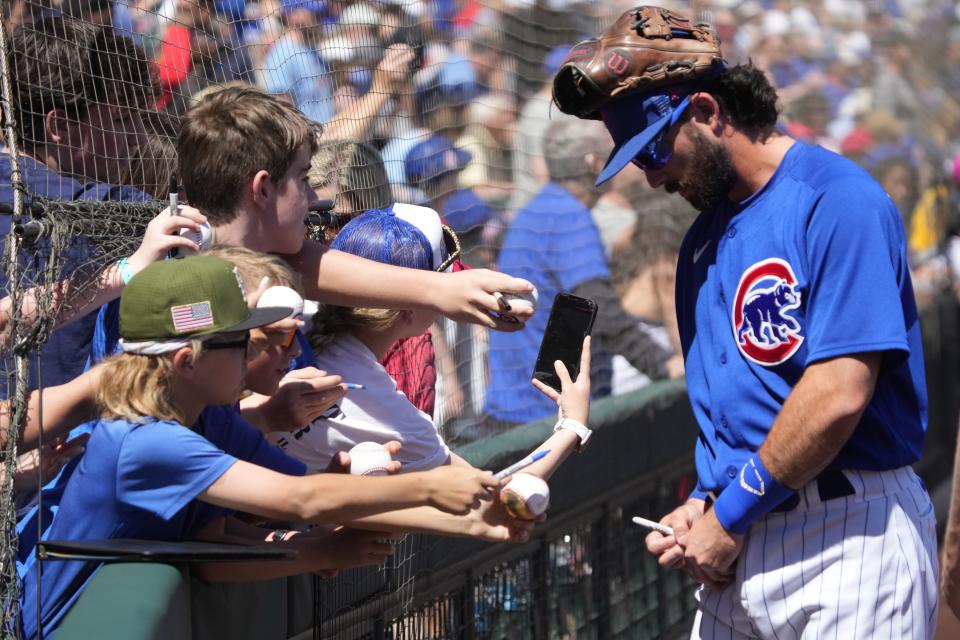Spring training is no longer an affordable experience
Mark Carlson started selling beer at Arizona spring training games in 1994. Tickets were routinely $10 or less. Beers were $2. It was common to walk up to the stadium right before first pitch and buy a last-minute seat. The event was much less about the game, and more about the opportunity to take in the beautiful March sunshine at the ballpark.
Much has changed in the Cactus League since Carlson came to Arizona for the first time 29 years ago. Attending just one spring training game, let alone three or four of them, has become a costly endeavor.
“Now, a beer is like 12 and a half dollars,” Carlson said. “If I have season tickets at (Cubs stadium) Sloan Park, it’s $4000 for four seats for 18 games. And that’s not even including parking. It’s unbelievable how much things have gone up.”
First sign of change
These dramatic spikes in price stem from fundamental changes to spring training that took place after Carlson first began working as a vendor. In the early 1990s, Florida officials began to realize the revenue that spring training could produce. The state began investing in massive spring training complexes for Grapefruit League teams.
As they developed more infrastructure, they started to target franchises that played their spring baseball in the desert. The now-Guardians left Tucson in 1992 for Florida. At the time, this left Arizona with just seven MLB teams. All of a sudden, the state was at risk of losing all of its MLB teams to Florida.
The Sunshine State’s plans remained under the radar for quite some time. Former sportswriter and longtime spring training attendee Les Polk remembers this turbulent time vividly. Polk wrote a series of stories for the Phoenix Gazette in 1990 detailing Florida’s push to acquire more teams, which opened the eyes of Arizonans.

“That awoke everyone out of their slumber,” Polk said. “What evolved over the years since then is what you see in the Cactus League right now. These mega complexes with everything under the sun for the teams. Because if Arizona hadn’t started doing that, Florida was gonna do it all for every team and there wouldn’t be any spring training in Arizona.”
Florida was changing the fabric of spring training. Arizona government officials realized they had to keep pace in order to hold onto MLB franchises. Just as their counterparts had discovered in Florida, the opportunity for massive amounts of revenue became clear. Out-of-state visitors for the event would boost the economy tremendously.
New spring training complexes were constructed. Between 1994 and 2014, Arizona built eight new Cactus League stadiums, which now make up 80% of the 10 complexes in the valley. The White Sox arrived from Florida in 1997, and the Rangers and Royals followed soon after in 2002. In the late 2000s, the Dodgers and Reds joined the party, and the Indians made their return.
Fifteen MLB teams now call the Phoenix area home every spring. As new stadiums have been built, spring training has increasingly become a huge revenue-generating operation, while simultaneously becoming a costly endeavor for fans.
Out-of-town visitors
A 2018 study conducted by Arizona State University’s W.P. Carey Business School sheds light on the extent to which the Cactus League impacts Arizona each year. The total economic impact of the 2018 spring training season was estimated at $373 million. This included the creation of 6,439 year-round jobs, paying a combined $224.6 million. The significance of the event for Arizona’s economy becomes readily apparent.
This degree of revenue is only possible because of the Cactus League’s ability to attract “out-of-area” visitors who are willing to spend thousands of dollars. Sixty percent of fans attending games in 2018 were out-of-towners, highlighting their importance to the whole operation.
Travel parties spent an average of $405 per day, with 41% of fans spending $500+ dollars, according to the Carey Business School study. In total, travel parties spent $1,860 on average, with 48% paying over $2,000 for their trips. (The Carey study considers travel parties to be three people on average.)
For many fans from other states, traveling to the valley to see their favorite team at spring training has become a family tradition. A third of the fans surveyed in the Arizona State study have been attending the event for five years or more. The sentimentality behind the trip means that the cost is of less importance. Some of these fans will be making the journey regardless of how expensive it is.
“It’s not a cheap vacation like it might have been 20 years ago,” Polk said. “It’s a destination in March for many baseball fans who want to have a vacation somewhere sunny and warm. Spring training fans from out of state who make a commitment to go to spring training are more diehard baseball fans.”

Carlson began working at Scottsdale Stadium, the San Francisco Giants’ home ballpark, in 2001. He is amazed by what tickets cost now.
“The impact I’ve seen at Scottsdale Stadium is ticket prices for the good seats,” Carlson said. “They’re $95 for a spring training game. Who’s the demographic that’s paying $95 to see an exhibition game with non-starters? You’re paying $95 for an exhibition game to see Double-A and Triple-A players.”
Dynamic pricing
Certain teams with particularly passionate fanbases attract more out-of-towners in March, like the Giants and Chicago Cubs. After their first world championship in 56 years in 2010, the Giants decided to capitalize on tremendous demand, setting in motion a monumental shift to Cactus League ticket prices.
The team introduced dynamic pricing in 2011. This model operates like airline tickets. Games that the franchise deems more “desirable” will cost more, and tickets will grow more expensive as the game approaches.
Peter Corbett has been covering the Cactus League since 2000. He’s written extensively about the impacts of dynamic pricing since it was first used in spring training. Corbett points to a shift in the Giants’ management strategy as the root of the transition.
“The Giants were seeing that they could fill the stadium,” Corbett said. “Ticket brokers were buying tickets, and then upcharging, and I think the Giants looked at it and said, ‘Hey, why are we gonna let them make the money when we could be doing the same thing. When there’s high demand on a weekend game, we’ll raise our prices and make it a little bit harder for the ticket brokers to make the money.’”
After the Giants set the precedent with dynamic pricing, the Cubs and Angels instituted the policy soon after. These days, nearly all Cactus League teams have dynamic pricing in place for at least some games. Attending marquee games is more costly than Corbett could have ever imagined.
“Before dynamic pricing, you could get a lawn seat for $10 a decade ago or so,” Corbett said. “And it’s crazy now. I’ve seen $67 or more for a lawn seat. That’s just insane to me.”
Many Cactus League teams publish their ticket prices by section before the game slate begins each year, although many have recently elected to stop doing so. From 2011 to 2023, ticket price increases in each section generally ranged between $12 and $20.
The most expensive seat at the Angels’ Tempe Diablo Stadium was $29 in 2011. That seat now costs $50. A grandstand ticket that cost $10 is now $22. An infield box seat at a Cubs game in 2011 cost $30. At Sloan Park, Chicago’s home since 2014, it now sets one back $50. Reserved outfield seats increased from $19 to $36. These increases do not incorporate the impact of dynamic pricing, meaning a fan is likely to pay even more than the prices above.
The Diamondbacks were vocal about their resistance to dynamic pricing in the early 2010s, yet their listed prices between 2011 and 2023 have increased at similar if not higher rates to other teams. Dugout Reserve tickets are up to $47 from $21, while Baseline Reserve tickets have increased from $15 to $32.
COVID-19
The emergence of the COVID-19 pandemic in 2020 only exacerbated ticket prices. After the 2020 Cactus League slate was canceled, stadium capacity was severely limited in 2021. With attendance capped at 2,500 or below in most ballparks, resale tickets were the only option for most fans. The average resale ticket cost in 2021 was $82. A 2022 labor dispute between the MLBPA and the owners led to a shortened spring training season last year, further skyrocketing prices.
With fears of the pandemic extremely high, out-of-towners refrained from long trips out to the desert in 2021 and 2022. Cactus League teams and local governments were forced to change their strategies dramatically.

The Phoenix area economy suffered tremendously without the March tourism rush. An event with an estimated economic impact of $373 million all but disappeared during the pandemic. Businesses struggled with the loss of revenue.
Longtime Phoenix area sports radio personality Doug Franz, who now hosts his own podcast Doug Franz Unplugged, points out that the Cactus League needed Arizonans like never before. Yet, attendance was down dramatically in 2022 despite no capacity limits.
“It’s a smart move to offer a different price for locals because you’re not always going to get the traveler,” Franz said. “If you price out the local, what will end up happening is at a time when you need the local, you’re not going to be able to get them to come in.”
Local impact
Arizona baseball fans have felt the changes to the spring training landscape. Chris Jordan was born and raised in the Phoenix area. His family has been attending Cactus League games since he was a young kid. Growing up, his parents had season tickets for the Oakland A’s when they played at Phoenix Municipal Stadium. Jordan remembers fondly how special it was to watch baseball outdoors as an Arizona kid.
“Because the Diamondbacks play indoors, a core part of my baseball fandom is going to spring training games as a little kid,” Jordan said. “I actually got the sitting in the sun watching baseball experience that the rest of the country gets.”
In 2012, Jordan’s parents purchased A’s season tickets for $13 a ticket, with seats down the first baseline. At the time, Cubs games at Hohokam Stadium had comparable prices, charging 14 dollars for a similar spot. When the A’s left Phoenix Municipal Stadium in 2014, the Jordans decided to become Cubs season ticket holders at Sloan Park in 2014.
After the Cubs won the World Series in 2016, demand skyrocketed. This year, Jordan says, his parents paid $55 a ticket for 17 games, a $42 increase in 11 years.
“That’s face value, that’s what they’re buying from the team,” Jordan said. “We all know that if you’re buying from Ticketmaster that it’s significantly more expensive than that. That much more than beats the rate of inflation. That’s an insane growth in ticket prices in 10 years.”
Jordan is not exaggerating. The ticket price increases stretch far beyond expectations, according to the US Department of Labor inflation calculator. In 1961, a box seat at Scottsdale Stadium was $2.75. Adjusting for inflation, that would be $27.76 this year. As Jordan’s experience exemplifies, box seats often cost at least twice that much.

A seat at Phoenix Municipal Stadium that was $1.25 in 1961 would be $12.62. One would be hard-pressed to find a lawn ticket, let alone a seat, anywhere for that cheap in the Cactus League.
With price spikes, the makeup of the crowd has changed as well. At Cubs games, Jordan has seen far more out-of-towners in the seats over time.
“The big shift would be from smaller crowds who are fans of the team to a snowbird tourist event,” Jordan said. “Tickets have gotten so expensive because of demand that simply being there, especially at Cubs games, has felt like a show of wealth.”
At stadiums like Sloan Park and Scottsdale Stadium, high demand means team-sold tickets are often unavailable in the days leading up to games. The resale market enters the conversation. Fans looking to buy tickets within a week of the matchup will pay a premium. Lawn seats frequently cost upward of $20, and increase as the game approaches.
On the day prior to a matchup between the Cubs and White Sox on March 28th, a lawn seat was listed as $40 on the resale app GameTime. A seat on the right field side was listed as $57, and a ticket behind home plate was listed for as much as $149.
These costs came in spite of the game taking place on the last day of spring training, with many major leaguers having already left Arizona.
Efforts to combat pricing
Some stadiums are working hard to keep spring training affordable for fans. With demand tending to be lower on the west side of the valley, strategies often differ. Camelback Ranch and Surprise Stadium are striving to remain connected with the community.
Camelback Ranch, the home park for the Los Angeles Dodgers and Chicago White Sox, created an initiative this season allowing Glendale residents to purchase heavily discounted seats. Fans could purchase up to four tickets on the lawn or in baseline seats for $7 with the Glendale Resident Pass.
Within days of the announcement, hundreds of locals signed up to pre-register for the initiative. The Dodgers drew the third-most fans of any team this year.
In Surprise, the Kansas City Royals and Texas Rangers’ home has been committed to keeping prices low for years. Surprise Stadium has kept the cost of lawn seats at $8 for the last 10 years.
Kendra Pettis, the Surprise Sports and Tourism Director, has been working in spring training since 2005. She believes it is vitally important to keep the Surprise population engaged and excited about the Cactus League.
“We want spring training to be an amenity for our residents,” Pettis said. “We want it to be something that’s part of the community, to be a pride point for Surprise. So we look to make sure we’re opening it up to all types of fans.”

From February 24 to March 11, Surprise Stadium offered Resident Appreciation Days, where locals could purchase two tickets for $20. Throughout the season, a value menu with discounted food is offered.
Pettis said they saw strong resident numbers this season. Surprise Stadium’s attendance numbers rose above the pre-COVID year of 2019, a promising sign.
The park’s initiatives are designed to make spring training more family-friendly.
“It’s really important that families enjoy spring training and see these major league baseball players playing up close,” Pettis said. “I think it’s important the stadium is a big component of our community.”
Kids
Pettis’ feelings are shared by many. It is feared that rising Cactus League ticket prices will drive families away from attending the event. According to the Carey Business School study, just 16% of travel parties brought kids to spring training in 2018, down from 34% in 2015. Of the 14 Cactus League teams excluding the Rangers, no more than 25% of travel parties brought kids on their journey.
Franz is fearful of baseball’s declining audience. He believes the key to keeping the game alive is keeping the younger generation excited about the sport.
With players easily accessible, spring training provides a great opportunity for that. Fans can watch practices and workouts from just feet away, and the stadiums themselves are very compact.

“There is no area in all of sports that allows you to get closer to the sport itself than Major League Baseball spring training,” Franz said. “Spring training is a time for a kid to dream that they can be a pro player. If you’re playing tee ball, and you go to a game, the players are just doing what you do, and they don’t look gargantuan, like in football and basketball. If spring training is making sure that the kids are getting in touch with the athletes, then it will always be a selling point for baseball itself.”
The best way to grow the game is to get youth and high school baseball teams involved, says Thomas Harding, a longtime Rockies beat writer for MLB.com.
“Are they gonna spend the money on concessions and other goods? Probably not,” Harding said. “But are you creating baseball fans? Most definitely you are. Going through your school system, and seeing which schools can’t afford tickets, and getting them into the ballpark is vital, because that may produce your next great player.”
The impact of reasonable ticket prices on family representation in the stadium is very noticeable. An Angels vs. A’s game at Tempe Diablo Stadium on March 21 featured tickets for $10 or less on the Gametime app. A Tuesday afternoon split-squad game meant demand was quite low. It cost $8 dollars to sit in the third row on the third-base line.
The fan makeup was striking. There were countless families, with kids munching on hot dogs and chasing after every foul ball. The lawn beyond the left field wall was filled with fans of all ages and demographics, all gathered on blankets and beach towels. There was a relaxed and welcoming nature to the environment, an atmosphere that many fondly associate with the Cactus League.
Preservation
It is this environment that spring training veterans hope is preserved going forward. Longtime vendor Dave Schneiter has developed close ties with fans over his 36 years working at the ballparks every March. He has seen the Cactus League become a much larger business over the years, but his relationships have remained strong.
“I have friendships with fans that are 30 years old. People come running up to me at the beginning of each spring training,” Schneiter said. “And our friendship continues throughout the year. We call each other and check in. And I’m part of their experience. I’m not doing it for the money anymore. You do it for the experience of reconnecting with old friends.”
Tim Sheridan has been doing public address announcing for Cubs spring training since 1984, back when he was a college student. Despite moving to Minnesota recently, he continues to travel back to Arizona every March. Back at Hohokam Stadium, the Cubs' previous spring training complex, there was always one thing that made Sheridan feel at home again: the smells of the ballpark.
“The press box where I did my public address announcing was directly above the main concession stand,” Sheridan said. “So when I would come each spring, I would get this smell of hamburgers, hot dogs, popcorn, this amalgam of amazing smells. And it would reconnect me. Oh, I’m at spring training again. That’s pretty powerful.”
It’s an indescribable feeling that every baseball fan ought to be able to experience for generations to come: spring baseball. The wins and losses don’t matter. Simply being there produces a lasting memory.
Jordy Fee-Platt is a graduate student at Arizona State University's Walter Cronkite School of Journalism and Mass Communication.
This article originally appeared on Arizona Republic: Spring training is no longer an affordable experience

